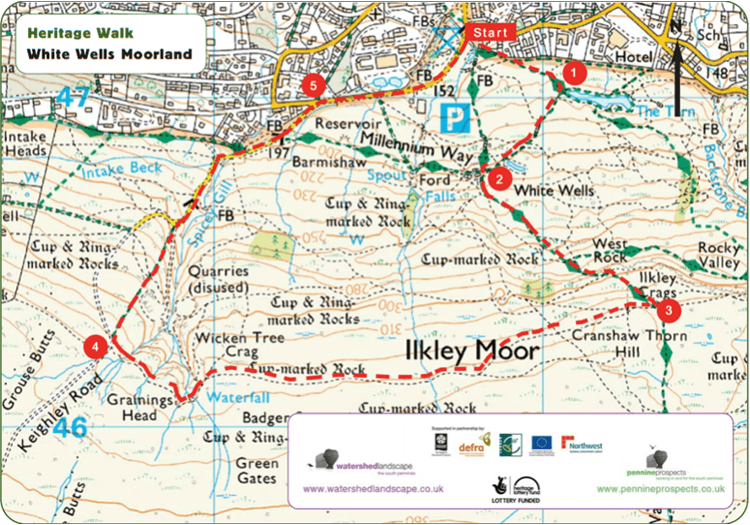
The area of the moor above Ilkley has a great variety of landscape and habitat. This walk takes you from the edge of the town on to the high moor, with wide views across Ilkley and the Wharfe Valley. The walk takes about two hours and is on reasonable paths, although there will be muddy areas in wet weather. The first part to Waypoint 3 is all uphill but with a good break halfway at White Wells. The walk starts at Darwin Gardens, up Wells Road from the town centre.
Start Darwin Gardens. From the Darwin Gardens car park turn left and cross the cattle grid. Immediately turn right and go through the gate beside Blue Plaque “Hillside”; the big house with the Blue Plaque. This house was a boarding house for visitors who came to Ilkley to take the waters. Darwin stayed here in 1858, it was then known as “Wells Terrace”. Take the tarmac lane behind the houses until you reach the Tarn at Waypoint 1. Your path takes the stone steps on the right, going up a bank, but it is worth making a ten minute circuit of the Tarn. This area was set out as a pleasure park in Victorian times and it is still a popular stroll for Ilkley people.

Waypoint 1
Just where the path meets the end of the Tarn you will see some stone steps on your right. Climb these and follow the path uphill. After five minutes you will pass the Upper Tarn and then arrive at White Wells Cottage at Waypoint 2.
Waypoint 2
At White Wells you can visit the old spring and bath, long thought to have restorative properties. When the flags are flying you can also get refreshments. Behind the house you will find a well made path leading up past the hillock with trees and benches – a good viewpoint. Continue along this path for 300 m, rising steadily towards the end of Ilkley Crags. The path steepens and there are broken stone steps that take you up and round the right hand end of the crag. At the top of the crag the path levels and you soon come to junction with a large pile of stones at Waypoint 3.
Waypoint 3
Turn right up the hill. After 100m the path drops and you will see your way ahead as the path continues across level moorland. Away to your left you will see the twin aerials of the radio station. Ahead of you are the conifers of the plantation. Now you are higher the bracken has been left behind and you are crossing grass with patches of bilberry and heather. Further down to your right there are larger patches of bog cotton grass, with its distinctive fluffy seedhead in the summer.
This area is the northern flank of the moor with Ilkley below you. Below are the stands of Austrian Pines, planted over a hundred years ago, and further below you will see the reservoir that provides Ilkley’s drinking water. In the spring and summer you will also see and hear skylarks which nest here, so please keep any dogs on a lead at this time. About half an hour after leaving waypoint 3 you will cross the top of a small valley, with several tributaries of Spicy Gill, the main drainage of this part of the moor. Ten minutes after leaving the valley you meet a surfaced lane at Waypoint 4.
Waypoint 4
This lane is Keighley Old Gate, the only motor road across the Moor, but it is in poor repair and not passable by most traffic. Turn right down the hill. In front of you is the Wharfe Valley with Beamsley Beacon and Round Hill beyond. Further across to the left you will see the upper Wharfedale valley leading into the hills by way of Addingham, Bolton Abbey and Burnsall. After 50m you reach a signpost for a footpath to the right. You can continue down the road, but the footpath is more pleasant and joins the road after 500m. After 100m you pass above a small quarry, with a similar one on the opposite side of the stream. This provided building stone – the familiar grey grit of northern towns. The path steepens and you re-join the lane. After a couple of bends you cross a small bridge over Spicy Gill and continue down the hill until you meet the road at Westwood Lodge at Waypoint 5.
Just before you reach Spicy Gill we recommend you take a 100yd detour to your left. Here you will find a solid looking bench and a boulder known as “The Badger Stone”. This stone has many interesting prehistoric cup and ring carvings on the side and rear. Don’t be fooled by the dark and rougher indentations, these are caused by high velocity bullets!. Have a rest on the bench and take in the pleasant view north up the Wharfe Valley.
Waypoint 5
Westwood Lodge is a large Victorian detached villa, latterly a convalescent home and then bought by Ilkley College. Turn right and pass a fine stand of horse chestnut trees on your left, and then the grand Wells house, standing behind the lake. Wells House was a hydropathic hotel designed by Cuthbert Broderick, architect of Leeds Town Hall. It opened in 1856. In 1859 Charles Darwin stayed here at the time of the publication of On the Origin of Species. Proceeding past Wells House you come back to your starting point, Darwin Gardens, on your left to complete the walk.
